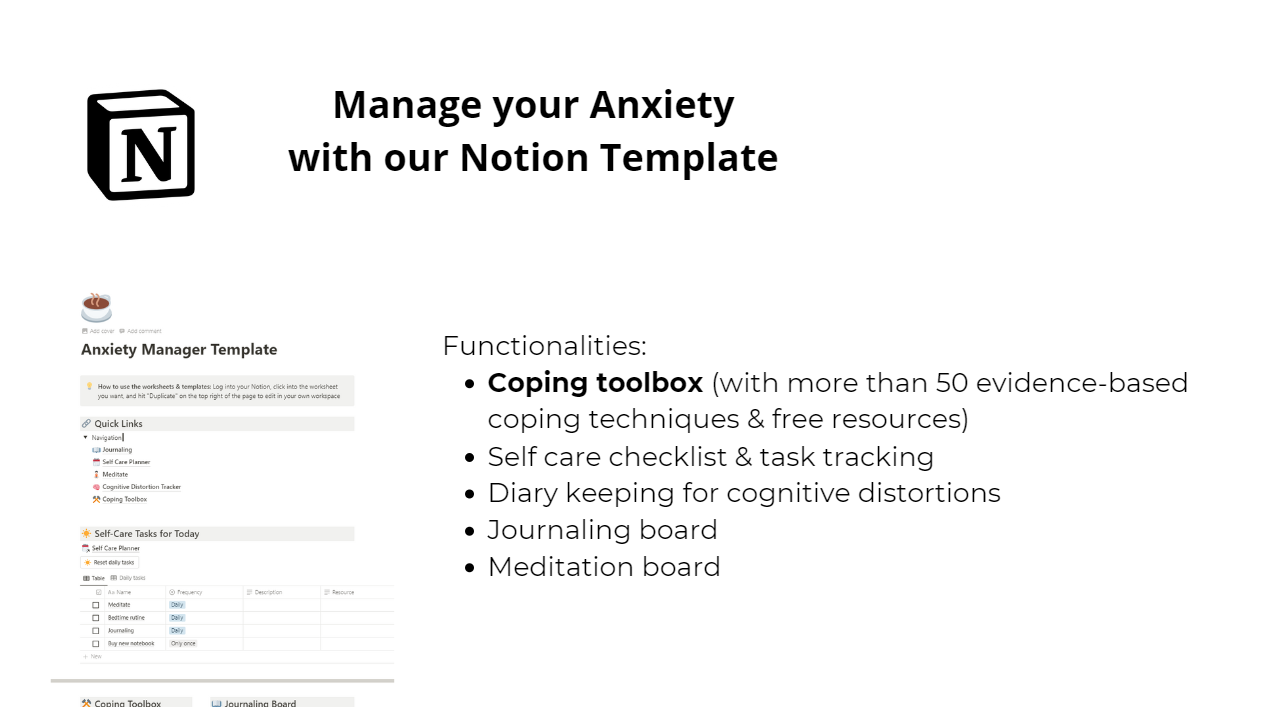The noting technique or noting meditation, is a meditation technique, also called “Mental noting,” which is part of a series of mindfulness practices.
What is Noting Meditation?
When experiencing anxiety, it can be very hard to control unwanted thoughts. This is why, rather than trying to change or control your thoughts, sometimes it can be more effective to just acknowledge, and focus on a distraction. With meditation, you usually focus on your breath, which acts as a distraction. There is actually research (1) that shows that trying to suppress your intrusive thoughts is less effective at suppressing them than just trying to focus on an alternative task or a distraction.
So, the noting meditation has two key elements:
- “Noting” what you are thinking or feeling, acknowledging it, and accepting it.
- Focusing your attention on your breath, which acts as a distraction.
The noting meditation consists of “noting” what you are thinking or feeling with only one word. It can be sensory (“stomach pain”), emotional (“sadness”), or cognitive (“thinking”). Noting is about acknowledging what you are feeling or thinking without being judgmental about it. However, it is not about trying to note every single thought or feeling, just the ones that really seem to distract you.
For the distraction part, you can count your breaths. One for breathing in, two for breathing out. You can do that until you reach ten, then you go back to zero.
We recommend this 10 minute meditation using the noting technique from Headspace meditation.
What research says
Now, for the science. First, let’s talk about the research on “noting” how we are feeling. In this study (2), Professor David Creswell found one particular component of meditation that made it effective against anxiety: recognition of emotional states through a non-judgmental approach.
There were 3 control groups:
- Participants attending a mindfulness program, which included the noting technique.
- Participants who engaged in stress management techniques (a supportive social environment, instructor’s attention, physical exercise).
- Participants who did nothing.
In the end, the group of participants who attended the mindfulness program were the ones who showed the most improvement in symptoms of anxiety, followed by those who attended the stress management program. So gently acknowledging what you are feeling and “noting it” can be a really powerful tool.
Now, there is also research that shows that distractions, such as focusing on your breath, can be really effective at trying to suppress distressing thoughts. There was a study (1) conducted where participants were asked to perform the following tasks:
- Trying to suppress some distressing thoughts
- Trying to suppress the thoughts by focusing on a distraction task (focused-distraction)
- Just focusing on a distraction task (concentration)
- Thinking about anything without restrictions
In the end, it was found that focused distraction and concentration were much more efficient in reducing intrusive thoughts than actively trying to suppress the distressing thoughts.
Now, let’s go from theory to practice.
Practical application
So this is how to actually put in practice mental noting:
- Preparation:
- Get comfortable. Try to go to a quiet space. You can sit, or lie down.
- Listen to a guided noting meditation. You can use the one from Headspace we mentioned before. However, there a lot of free guided meditations using the noting technique online, such as on YouTube.
- Use one word to describe what you are feeling (“note it“) when experiencing anxiety. It can be sensory (“stomach pain”), emotional (“sadness”), or cognitive (“thinking”). These are just a few examples.
- Try to include meditating into your daily routine. For example, you can meditate before you go to sleep. Not only is it a time when everything is generally quieter, but it can also help you to fall asleep faster.
- It can be beneficial to meditate not only when you are feeling stressed or anxious, but also when you are feeling calm.
Here is a list with more examples:
- Sensorial: stomach pain, pressure, tightness, tension.
- Emotional: happiness, sadness, excitement, fear.
- Cognitive: thinking, resisting, wanting, planning.
- There are some that do not fit any category, like impatience, restlessness.
How to Include Meditation in Your Routine
In order to better keep track of your habits and include meditation in your daily routine, we created Anxiety manager Notion template, which includes:
Anxiety Manager – Notion template
🌟 Introducing the Ultimate Anxiety Management System 🌟

Our Notion template is here to help you on your journey towards better anxiety management.
🌟 What is Included: 🌟
📚 Coping ToolBox: Access a curated collection of coping tools and resources. (More than 50 evidence-based coping techniques, with free resources).
🌼 Self-Care Planner: Create a daily routine tailored to your needs. Effortlessly track your habits and stay accountable.
📔 Cognitive Distortions Diary: Record and reflect upon your cognitive distortions, gaining valuable insights into your thought patterns.
📔 Journaling Calendar: Foster self-reflection and personal growth with a dedicated journaling calendar.
🧘 Meditate Board View : Create a space for your meditation resources. Store guided meditations, calming music, and mindfulness exercises.
🚀 Don’t wait any longer. Take the first step towards a more fulfilling life. Get your Ultimate Self-Care Notion Template now and make self-care a daily habit!
Sources
(1) Lin, Y.-J., & Wicker, F. W. (2007). A comparison of the effects of thought suppression, distraction, and concentration. Behaviour Research and Therapy, 45(12), 2924-2937. https://doi.org/10.1016/j.brat.2007.08.004
(2) Hölzel, B. K., Hoge, E. A., Greve, D. N., Gard, T., Creswell, J. D., Brown, K. W., Barrett, L. F., Schwartz, C., Vaitl, D., & Lazar, S. W. (2013). Neural mechanisms of symptom improvements in generalized anxiety disorder following mindfulness training. NeuroImage: Clinical, 2, 448-458. https://doi.org/10.1016/j.nicl.2013.03.011

Leave a Reply